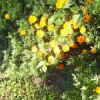Creosote is not the only danger of railroad ties. They are also regularly sprayed with highly toxic herbicides, bactericides and fungicides (including PCP).
Here are the questions asked by community members. Read on to see the answers provided by the ThriftyFun community.
Hardiness Zone: 8a
Sandra from Mississippi
A: Sandra,
Personally, I wouldn't recommend using poles, logs or landscape timbers containing coal tar creosote for gardening. The fact is that about 300 chemicals known to be toxic have been identified in coal tar creosote (common to landscape logs and poles), but it may contain as many as 10,000 other chemicals. Some of these toxic chemicals dissolve in water and move through the soil, eventually reaching our groundwater.
Once in the groundwater, breakdown may take years. Many components that make up creosote are not water soluble, but will still leech out into the soil where they will remain in place in a tar-like mass. Breakdown in soil can take months or longer. Sometimes, small amounts of the chemicals remaining in the soil or water that take a long time to break down are still toxic to some animals and possibly to humans.Once coal tar creosote is in the environment, both plants and animals can absorb parts of the creosote mixture. How much of these chemical components will be taken up by your flowers depends on a variety of environmental conditions. They may or may not appear to harm your plants, but the chemicals will be causing unseen damage to the environment whether your plants are harmed or not. The fact that products containing creosote cannot be sold to consumers in most European countries and that many hazardous waste sites slated for clean up in the United States contain creosote residues is a good indicator of its toxicity. These same concerns also apply to other chemically treated wood products.
Ellen
Not a good idea I read it is toxic to even sit on them. The creosote leaches into the soil and your soil will be contaminated forever.
Aren't railroad ties covered with creosote? I believe they are, and they are sold for enclosing gardens and landscaping--I've used them for years with no problems.
Why not look at this picture another way. Ellen isn't telling you that the new kind of treating of wood is worse than creosote.
I am looking for information on remediation of creosote logs in the garden. I am curious about plugging the logs with oyster mushrooms for remediation. The raised beds with the logs are not being used for food cultivation.
I would like to remediate them on the spot rather than take them to the dump. Any ideas, info or links would be most appreciated. Thanks.
Hardiness Zone: 8b
By Nikki from Portland, OR

Search for: Remediating Creosote Logs in the Garden; good luck.